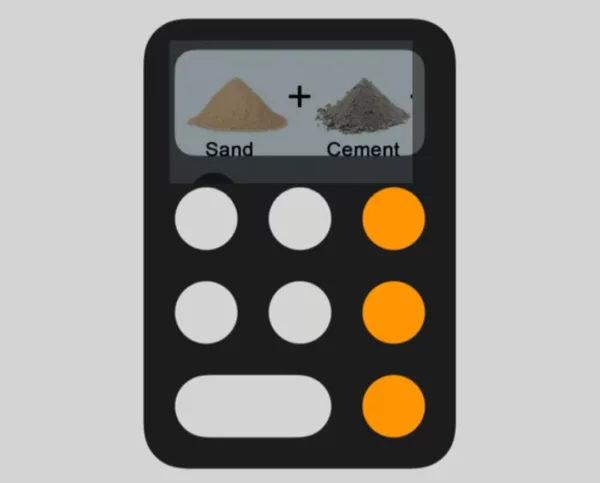This Ballast calculator is designed to effortlessly estimate the amount of ballast and cement you needed for any volume and mix ratio of concrete to ballast mix.
Calculate Cement to Ballast
Whether you’re a DIY enthusiast or a professional builder, using this user-friendly calculator can streamline your material estimation process and prevent unnecessary expenses or shortages.
Ballast Calculator
Volume (m³):
Concrete Mix Ratio (cement:ballast):
Cement Needed: 0 kg
Ballast Needed: 0 kg
How to Use the Ballast and Cement Calculator
By obtaining precise measurements for cement and ballast, you can confidently move forward with your project, knowing that you have the right resources at hand.
- Enter the total volume of mortar required for your project in cubic meters.
- Select the mix ratio (cement: ballast) from the dropdown menu.
- Click the “Calculate Materials” button to get the estimated amount of cement and ballast needed for your project, displayed in kilograms.
Why Use a Ballast Calculator?
Using a ballast and cement calculator helps you save time and money by providing an accurate estimate of the materials needed for your construction project.
This enables you to plan ahead, order the right amount of materials, and avoid costly mistakes.
Additionally, using the right mortar mix ratio is crucial for achieving the desired strength and durability in your project.
What is Ballast for Concrete
Ballast for concrete plays a crucial role in ensuring the strength and durability of concrete structures. Ballast, in the context of concrete, refers to the aggregate material used to enhance the structural qualities of the concrete mix. It acts as a support system for concrete, adding weight and stability to the mixture.
Without ballast, concrete would lack the necessary strength and durability required for various construction applications.
Tips for Mixing and Using Ballast in Concrete
- Follow our guide for mixing concrete. This includes the correct mix ratio, mixing technique, and water content.
- Use clean, potable water when mixing ballast to ensure a consistent and strong mix.
- Mix the mortar in small batches to ensure it remains workable and does not harden before it can be used.
- Apply mortar evenly and consistently to ensure proper bonding between bricks or blocks.
- Allow the concrete to cure properly as this aids in achieving the desired strength and durability.
FAQs
What is the purpose of ballast in a concrete mix?
Ballast provides strength, stability, and bulk to the concrete while reducing shrinkage during the curing process.
It also helps improve the workability, durability, and resistance of the concrete to environmental factors like freeze-thaw cycles and abrasion.
Ballast, also known as coarse aggregate, is a crucial component in concrete mixtures. It consists of materials like gravel, crushed stone, or recycled concrete, which serve several purposes in the mix.
How do I choose the right concrete mix ratio using ballast?
In general, a stronger mix is recommended for load-bearing structures, foundations, and elements exposed to harsh weather conditions, while a weaker mix may be sufficient for non-structural elements and less demanding applications.
Choosing the right concrete mix ratio (cement: sand: ballast) for your project depends on factors such as the project’s structural requirements, the type of application, and environmental conditions.
Common concrete mix ratios include 1:2:4, 1:3:6, and 1:4:8, with 1:2:4 being the strongest and 1:4:8 being the weakest.
Always consult with a structural engineer or an experienced builder to determine the appropriate concrete mix ratio for your project.
How much ballast do I need?
The amount of ballast you need depends on how much concrete you want to mix and the desired ballast mix ratio. Use our calculator to help you determine the amount of ballast you require.
How much ballast per 1m3 concrete?
In general, ballast can make up about 60% to 80% of the total volume of coarse aggregate in concrete.
For example, if you’re using a mix design with a total of 6 parts (1 part cement + 2 parts sand + 3 parts ballast), and you want to make 1 cubic meter of concrete, you would need:
So, you would need 0.5 cubic meters of ballast to make 1 cubic meter of concrete using this particular mix design.
The amount of ballast required for 1 cubic meter of concrete can vary depending on the specific mix design and desired concrete properties.
Conclusion
This ballast and cement calculator is a valuable tool that can help you accurately estimate the amount of materials needed for your construction project, allowing for better planning and budgeting.
By taking into account factors such as the required concrete mix ratio, project dimensions, and structural requirements, the calculator provides a reliable estimation for your project.
Understanding the role of ballast in concrete, choosing the right mix ratio, and ensuring proper curing of the concrete are essential aspects of a successful construction project.
Remember, accurate mixing and careful curing contribute significantly to the strength and longevity of your construction.
So, make the most of this Cement to Ballast Calculator and enjoy a smoother, more informed construction journey.
Author Profile

- I have many qualifications and certificates in construction, such as City & Guilds, CPCS and CITB. These are the highest standards of training and competence in the industry. Whether you need help with plumbing, carpentry, bricklaying or any other trade, I’m here to help you succeed.
Latest entries
- March 6, 2024CalculatorsWall Tile Calculator: How Many Wall Tiles Do You Need
- February 29, 2024Roof Truss Cost Calculator
- December 31, 2023Wage Take Home Calculator
- December 30, 2023Day Rate Calculator

